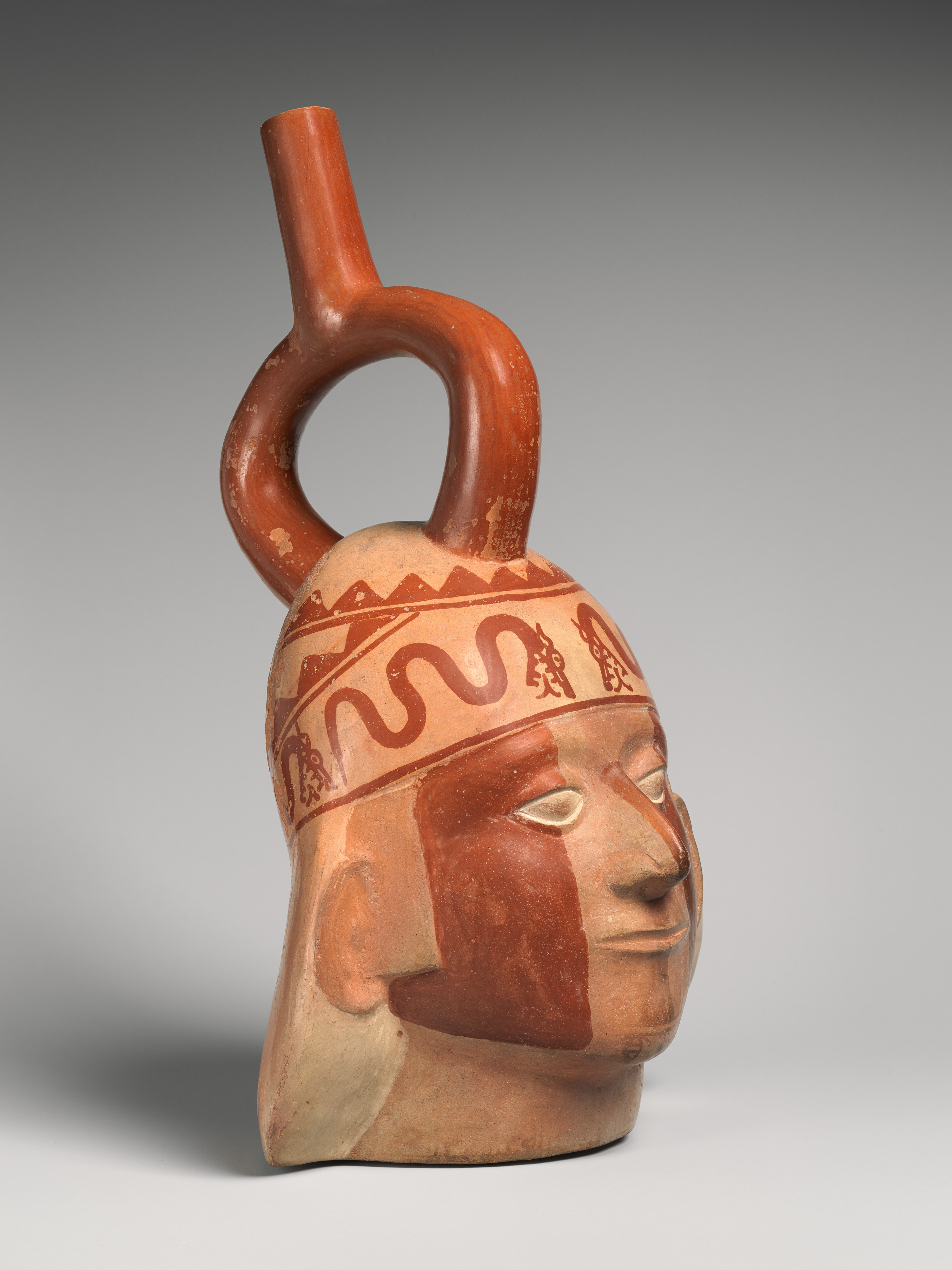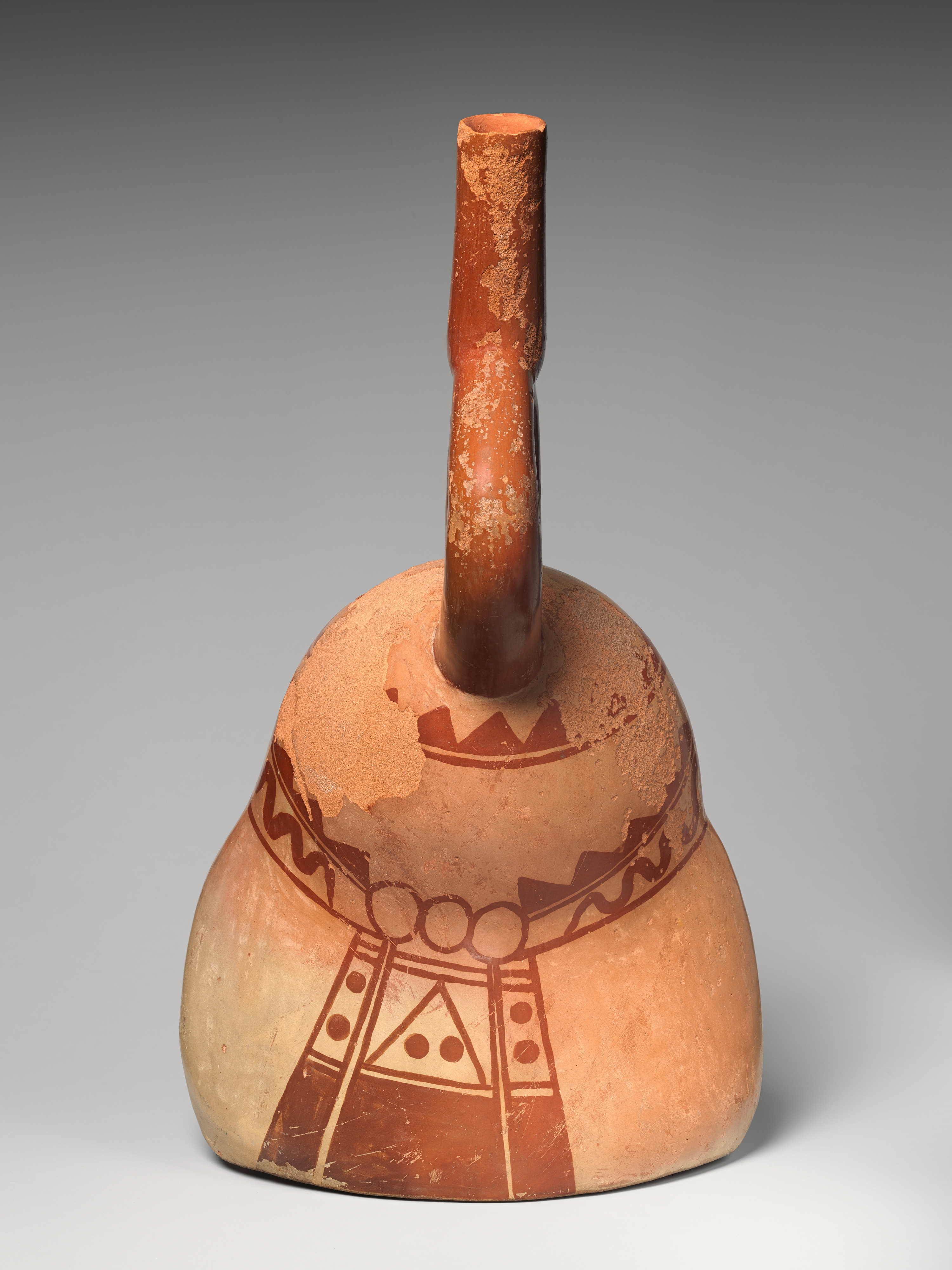Portrait Head Bottle
Not on view
Moche potters of Peru’s North Coast produced tens of thousands of modeled and painted ceramic vessels over the course of some six centuries between the third and ninth centuries AD, well before the rise of the Inca Empire in the fifteenth century. The Moche built thriving regional centers from the Nepeña River Valley in the south to perhaps as far north as the Piura River, near the modern border with Ecuador, developing coastal deserts into rich farmlands and drawing upon the abundant maritime resources of the Pacific Ocean’s Humboldt Current. Although the precise nature of Moche political organization is a subject of debate, these centers shared unifying cultural traits such as religious practices (Donnan, 2010).
Stirrup-spout bottles—the shape of the spout recalls the stirrup on a horse's saddle—were a much-favored form on the North Coast for about 2,500 years, from at least the beginning of the first millennium B.C. through the early colonial period. The double-branch-single-spout configuration may have had practical advantages, as an ingenious handle, but it was also surely symbolic. As there was no tradition of writing in this region prior to the sixteenth century, however, the specific meanings of the shape remain unknown. The bodies of the vessels were shaped into a wide range of forms, including human figures, animals, and plants, and combinations of these. Such vessels were used in specific rituals; many, but not all, were ultimately placed in tombs.
Portrait heads—so-called for their striking apparent resemblance to specific individuals—are a subset of this larger corpus of vessels. Their production was limited in time and space: they have been found only in the southern Moche region—south of the Pampa de Paiján, in the Chicama, Moche, and Virú valleys—and the most lifelike examples date to the later part of the Moche period, Phases III and IV (Donnan, 2001; 2004). Created with the use of molds—multiple vessels were made with the use of a single mold or matrix—the bottles were then painted with cream and red slip in distinctive ways. In some cases, it has been possible to recognize the same individual at different stages of their lives, from youth to middle age.
The present example is one of several likely to have been made from a single mold, or molds made over the same matrix (Donnan 2004, 94). The other two vessels are in Chicago, at the Field Museum of Natural History (accession number 100076) and Lima, at the Museo Nacional de Antropología, Arqueología, e Historia, and they differ in the designs of the headband. The individual depicted here wears a head cloth over his hair, painted in a cream slip. He also wears a headband decorated with a geometric border beneath which are four undulating serpents, two on each side, facing each other at the center of the forehead. The profile serpents have open maws, revealing bared teeth and bifurcated tongues. The individual is depicted wearing face paint, including a bold cream-colored vertical stripe down the center of the face, with red detailing along the bridge of the nose and a triangle below the mouth on the chin, and two red stripes flanking the central cream stripe. Stepped motifs were painted on the neck, and just below the chin on the lower jar are a series of lozenge-shaped forms, perhaps representing pupae. Archaeologist Steve Bourget (2001:104) has suggested that these represent muscoid flies emerging from their pupal cases, a symbol of transformation in the liminal stages of death.
It is difficult to state with certainty how portrait vessels were viewed in the past. Based on a comprehensive study of some 900 portrait heads and related archaeological data, Christopher Donnan (2001, 2004) has argued that they represented prominent individuals who would have been known by members of their community. Other scholars have emphasized their final contexts in burials, suggesting that such vessels are literal representations of decapitated heads, acts of reverence or devotion by kin (Weismantel, 2015).
Joanne Pillsbury, Andrall E. Pearson Curator, Arts of the Ancient Americas, 2021
References and further reading
Castillo, Luis Jaime, Cecilia Pardo, and Julio Rucabado. Moche y sus vecinos: Reconstruyendo identidades. (Lima: Museo de Arte de Lima, 2016).
Donnan, Christopher B. “Moche State Religion,” in New Perspectives on Moche Political Organization, edited by Jeffrey Quilter and Luis Jaime Castillo (Washington D.C.: Dumbarton Oaks Research Library and Collection, 2010), pp. 47-69.
Donnan, Christopher B. Moche Portraits from Ancient Peru (Austin: University of Texas Press, 2003).
Donnan, Christopher B. “Moche Ceramic Portraits,” in Moche Art and Archaeology in Ancient Peru, edited by Joanne Pillsbury (Washington, D.C., New Haven: National Gallery of Art; Distributed by Yale University Press, 2001), pp. 126-139.
Donnan, Christopher B. and Donna McClelland. Moche Fineline Painting: Its Evolution and Its Artists (Los Angeles: Fowler Museum of Cultural History, University of California, Los Angeles, 1999).
Donnan, Christopher B. Ceramics of Ancient Peru (Los Angeles: Fowler Museum of Cultural History, University of California, Los Angeles, 1992).
Trever, Lisa. “A Moche Riddle in Clay: Object Knowledge and Art Work in Ancient Peru.” The Art Bulletin 101:4 (2019), pp. 18-38.
Weismantel, Mary. “Many Heads are Better than One: Mortuary Practice and Ceramic Art in Moche Society,” in Izumi Shimada and James L. Fitzsimmons, eds., Living with the Dead in the Andes, pp. 76-99. Tucson: University of Arizona Press, 2015.
Wołoszyn, Janusz Z., and Francisco Javier Villaverde González. Los rostros silenciosos: Los huacos retrato de la cultura moche. Lima, Peru: Fondo Editorial, Pontificia Universidad Católica del Perú, 2008.
Due to rights restrictions, this image cannot be enlarged, viewed at full screen, or downloaded.
This artwork is meant to be viewed from right to left. Scroll left to view more.





